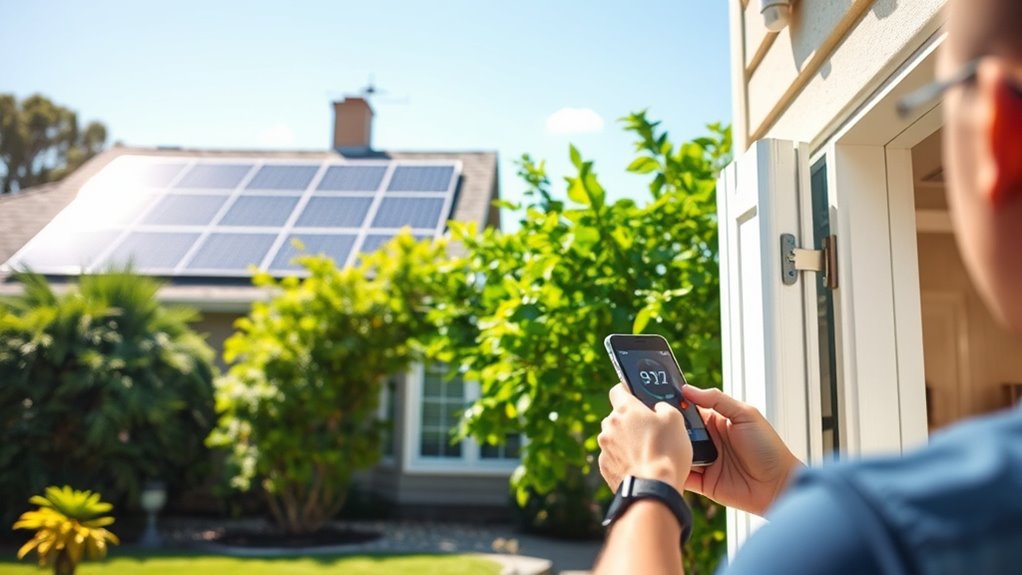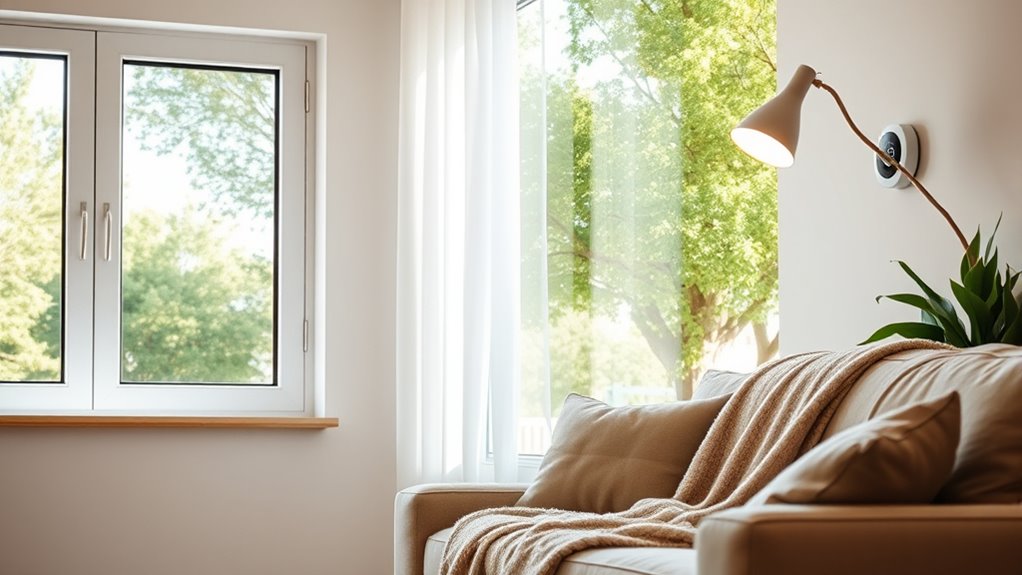To lower your home energy bills, consider upgrading to smart thermostats that learn your schedule and can be remotely controlled. Use energy-efficient appliances with high Energy Star ratings to save on utility costs. Adopt simple behavioral changes like sealing drafts, using curtains wisely, and running appliances during off-peak hours. Keeping up with regular maintenance and upgrades guarantees systems run smoothly. Explore these options further to discover even more ways to cut costs effectively.
Key Takeaways
- Install smart thermostats to optimize heating and cooling schedules, reducing unnecessary energy use.
- Upgrade to energy-efficient appliances with high Energy Star ratings for long-term savings.
- Seal doors and windows, and use curtains to minimize heat loss and gain.
- Perform regular maintenance and consider insulation upgrades to improve system efficiency.
- Use behavioral strategies like running appliances during off-peak hours and adjusting thermostats appropriately.

Are you looking for ways to cut down your monthly energy costs? One of the most effective strategies is to upgrade to smart thermostats and energy-efficient appliances. These devices can substantially reduce your energy consumption without sacrificing comfort. Smart thermostats, in particular, give you the ability to control your heating and cooling remotely, allowing you to adjust the temperature when you’re not home or during sleeping hours. This prevents unnecessary heating or cooling, saving you money on energy bills. Many models learn your schedule over time and automatically optimize your settings, ensuring your home stays comfortable while consuming less power. Plus, they often come with energy usage reports, helping you identify patterns and further refine your habits.
Switching to energy-efficient appliances is another smart move. Modern appliances like refrigerators, dishwashers, washing machines, and dryers are built to use less energy while maintaining or even improving performance. Look for products with high Energy Star ratings, which indicate they meet strict efficiency standards. Although these appliances may cost more upfront, they pay off over time through lower utility bills. For example, an energy-efficient refrigerator uses less power to keep food cold, and a washer that uses less water and electricity can cut your utility bills considerably. Combining these appliances with your existing systems can lead to noticeable savings in your monthly expenses.
In addition to technological upgrades, you can implement simple behavioral changes that complement the use of smart thermostats and energy-efficient appliances. Keep doors and windows sealed to prevent drafts, especially during extreme weather. Use curtains or blinds to block out heat during the summer or retain warmth during winter. When possible, run appliances during off-peak hours, which are often cheaper and less stressful on the grid. Also, setting your thermostat a few degrees lower in winter and higher in summer can make a big difference without sacrificing comfort. These small habits, combined with the right equipment, maximize your savings.
Another consideration is to look into Kia Tuning options for your vehicle, as improvements in engine efficiency can also contribute to reduced fuel costs and environmental impact, similar to how energy-efficient appliances help lower utility bills.
Finally, don’t forget about regular maintenance. Clean filters in your HVAC system and appliances ensure they operate efficiently. Schedule annual inspections to keep everything running smoothly, and consider upgrading insulation if your home loses heat or cool air easily. In the end, lowering your home energy bills involves a mix of investing in smart, energy-efficient technology and adopting mindful habits. These steps not only save you money but also reduce your carbon footprint, making your home more sustainable in the long run.
Frequently Asked Questions
Are Energy-Efficient Appliances Worth the Initial Investment?
Energy-efficient appliances are definitely worth the initial investment because they save you money in the long run through lower energy bills. Plus, they often have a longer appliance lifespan and require less maintenance, saving you time and costs over time. By choosing these appliances, you’re making a smart move that benefits both your wallet and the environment, ensuring you get the most out of your investment.
How Can I Optimize My Thermostat Settings Year-Round?
To optimize your thermostat settings year-round, leverage smart thermostats for precise control. Make seasonal adjustments by lowering the temperature in winter and raising it in summer to save energy. Set your thermostat to energy-efficient temperatures when you’re away or asleep. These smart devices learn your habits and automatically adjust, ensuring comfort while reducing energy use. Regularly review and tweak your settings to maximize savings throughout the year.
What Are the Best DIY Insulation Techniques?
Your home’s comfort depends on mastering DIY insulation techniques—it’s like giving your house a cozy, energy-saving blanket. Start by upgrading attic insulation to prevent heat loss, and don’t forget to seal air leaks around windows, doors, and vents. These simple steps dramatically cut energy waste, saving you money and keeping your home warmer in winter and cooler in summer. You’ll notice the difference instantly, making your living space much more efficient.
Do Window Films Significantly Reduce Energy Costs?
Window films, like window tinting, can considerably reduce your energy costs by providing solar control. They block out heat from sunlight, keeping your home cooler in summer and warmer in winter. This means you’ll rely less on air conditioning and heating, saving you money. Installing solar control window films is a simple, cost-effective way to improve energy efficiency, making your home more comfortable and lowering your bills.
How Often Should I Schedule Professional Energy Audits?
You should schedule a professional energy audit at least once every three years, or more often if you notice increased energy bills or unusual home issues. During the audit, experts can assess your home’s efficiency, recommend improvements like home automation systems, or explore solar panel financing options. Regular audits help you stay proactive, identify savings opportunities, and make certain your home stays energy-efficient and cost-effective over time.
Conclusion
By implementing these tips, you’ll see your energy bills shrink and enjoy a more comfortable home. For example, Sarah saved over $200 a year after sealing her attic and upgrading her thermostat. Small changes add up quickly, so start today—whether it’s insulating your walls or switching to energy-efficient bulbs. With a little effort, you’ll cut costs and make your home greener, all while staying cozy and saving money every month.








